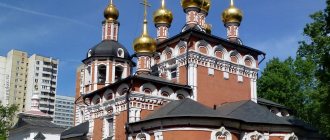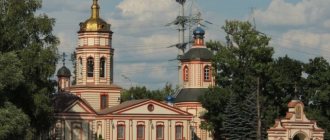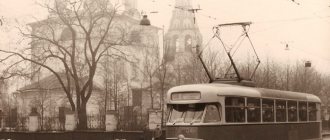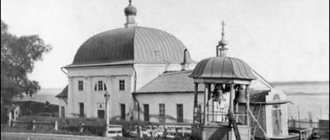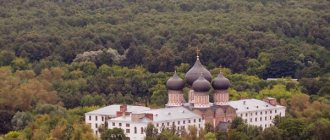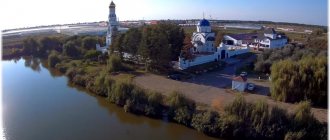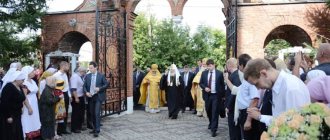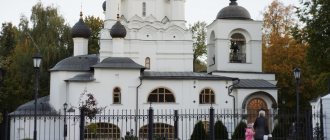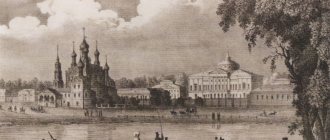Mir
Russia Moscow region Dubrovitsy village Church of the Icon of the Mother of God “The Sign” (Dubrovitsy) Map is loading…
{"format":"leaflet","minzoom":false,"maxzoom":false,"limit":50,"offset":0,"link":"all","sort":[""], "order":[],"headers":"show","mainlabel":"","intro":"","outro":"","searchlabel":"\u2026 \u0441\u043b\u0435\ u0434\u0443\u044e\u0449\u0438\u0435 \u0440\u0435\u0437\u0443\u043b\u044c\u0442\u0430\u0442\u044b","default":"","import-annotation":false,"width ":"auto","height":"350px","centre":{"text":"","title":"""link":"""lat":55.44129720000000105528670246712863445281982421875,"lon": 37.494408300000003464447217993438243865966796875,"icon":""},"title":"","label":"","icon":"","lines":[],"polygons":[],"circles":[ ],"rectangles":[],"copycoords":false,"static":false,"zoom":8,"defzoom":14,"layers":["OpenStreetMap"],"image layers":[] ,"overlays":[],"resizable":false,"fullscreen":true,"scrollwheelzoom":true,"cluster":false,"clustermaxzoom":9,"clusterzoomonclick":true,"clustermaxradius":80, "clusterspiderfy":true,"geojson":"","clicktarget":"","showtitle":true,"hidenamespace":false,"template":"","userparam":"","activeicon": "","pagelabel":false,"ajaxcoordproperty":"","ajaxquery":"","locations":[{"text":"\u003Cb\u003E\u003Ca href=\"/palomnik/%D0% A6%D0%B5%D1%80%D0%BA%D0%BE%D0%B2%D1%8C_%D0%B8%D0%BA%D0%BE%D0%BD%D1%8B_%D0%91% D0%BE%D0%B6%D0%B8%D0%B5%D0%B9_%D0%9C%D0%B0%D1%82%D0%B5%D1%80%D0%B8_%22%D0%97% D0%BD%D0%B0%D0%BC%D0%B5%D0%BD%D0%B8%D0%B5%22_(%D0%94%D1%83%D0%B1%D1%80%D0%BE %D0%B2%D0%B8%D1%86%D1%8B)\» title=\»\u0426\u0435\u0440\u043a\u043e\u0432\u044c \u0438\u043a\u043e\u043d\u044b \u0411\ u043e\u0436\u0438\u0435\u0439 \u041c\u0430\u0442\u0435\u0440\u0438 \u0026quot;\u0417\u043d\u0430\u043c\u0435\u043d\u0438\u0435\ u0026quot; (\u0414\u0443\u0431\u0440\u043e\u0432\u0438\u0446\u044b)\»\u003E\u0426\u0435\u0440\u043a\u043e\u0432\u044c \u0438\u043a\u043 e\u043d\u044b\u0411 \u043e\u0436\u0438\u0435\u0439 \u041c\u0430\u0442\u0435\u0440\u0438 \"\u0417\u043d\u0430\u043c\u0435\u043d\u0438\u0435\" (\u 0414\u0443\u0431\ u0440\u043e\u0432\u0438\u0446\u044b)\u003C/a\u003E\u003C/b\u003E\u003Chr /\u003E\u003Ca href=\"/palomnik/%D0%A1%D0%B2%D0%BE %D0%B9%D1%81%D1%82%D0%B2%D0%BE:%D0%90%D0%BD%D0%BD%D0%BE%D1%82%D0%B0%D1%86% D0%B8%D1%8F\" title=\"\u0421\u0432\u043e\u0439\u0441\u0442\u0432\u043e:\u0410\u043d\u043d\u043e\u0442\u0430\u0446\u0438\u044f\" "" 0417\u043d\u0430\ u043c\u0435\u043d\u0438\u044f \u041f\u0440\u0435\u0441\u0432\u044f\u0442\u043e\u0439 \u0411\u043e\u0433\u043e\u0440\u043e\u0 434\u0438\u0446\u044b»\u003Cspan class=\»smw-highlighter\» data-type=\»2\» data-state=\»persistent\» data-title=\»\u0418\u043d\u0444\u043e\u0440\u043c\u0430\u0446\ u0438\u044f\" title=\"\u0026#039;\u0026#039;\u0026#039;\u0426\u0435\u0440\u043a\u043e\u0432\u044c \u0417\u043d\u0430\u043c\u0435\ u043d \u0438\u044f \u041f\u0440\u0435\u0441\u0432\u044f\u0442\u043e\u0439 \u0411\u043e\u0433\u043e\u0440\u043e\u0434\u0438\u0446\ u044b\u0026#039;\u0026# 039;\u0026#039; \u0440\u0430\u0441\u043f\u043e\u043b\u043e\u0436\u0435\u043d\u0430 \u0432 \u0443\u0441\u0430\u0434\u044c\u0431\u0435 \u0414 \u0443\u0431\u0440\u043e\u0432 \u0438\u0446\u044b, \u043d\u0435\u043a\u043e\u0433\u0434\u0430 \u043f\u0440\u0438\u043d\u0430\u0434\u043b\u0435\u0436\u0430 \u0432\u0448\u0435\u0439\ u043f\u0440\u0435\u0434\u0441\u0442\u0430\u0432\u0438\u0442\u0435\u043b\u044f\u043c \u0441\u0442\u0430\u0440\u0438\u043d\u04 3d\u044b\u0445\u0434\u0432\ u043e\u0440\u044f\u043d\u0441\u043a\u0438\u0445 \u0441\u0435\u043c\u0435\u0439 \u041c\u043e\u0440\u043e\u0437\u043e\u0432\u0 44b\u0445,\u0413\u043e\u043b \u0438\u0446\u044b\u043d\u044b\u0445 \u0438 \u0414\u043c\u0438\u0442\u0440\u0438\u0435\u0432\u044b\u0445-\u041c\u0430\u043c \u043e\u043d\u043e\u0432\ u044b\u0445. \u0417\u043d\u0430\u043c\u0435\u043d\u0441\u043a\u0438\u0439 \u0445\u0440\u0430\u043c \u2013 \u0443\u043d\u0438\u043a\u0430 \u043b\u044c\u043d\u044b\u0439 \u043f\u0430\u043c\u044f\u0442\u043d\u0438\u043a \u0440\u0443\u0441\u0441\u043a\u043e\u0439 \u0430\u0440\u0445\u0438\u0442\ u0435\u043a\u0442\u0443\u0440 \u044b \u043a\u043e\u043d\u0446\u0430 XVII\u2013 \u043d\u0430\u0447\u0430\u043b\u0430 XVIII \u0432., \u0434\u0430\u0432\u043d\u043 e\u0432\u043e\u0448\u0435 \u0434\u0448\u0438\u0439 \u0432 \u0441\u043e\u043a\u0440\u043e\u0432\u0438\u0449\u043d\u0438\u0446\u0443 \u043c\u0438\u0440 \u043e\u0432\u043e\u0433\u043e \u0438\u0441\u043a\u0443\u0441\u0441\u0442\u0432\u0430. \u0421\u0442\u043e\u043b\u043f\u043e\u043e\u0431\u0440\u0430\u0437\u043d\u043e\u0435 \u0431\u0435\u043b\u043e\u043a\u0430\u 043c\u0435\u043d\u043d\u043e \u0435 \u0437\u0434\u0430\u043d\u0438\u0435, \u0432\u044b\u043f\u043e\u043b\u043d\u0435\u043d\u043d\u043e\u0435 \u0432 \u04 41\u0442\u0438\u043b\u0435\ u0431\u0430\u0440\u043e\u043a\u043a\u043e.\»\u003E\u003Cspan class=\»smwtext\»\u003E \u2026 \u003C/span\u003E\u003Cspan class=\»smwttcontent\»\u003E» ' \u0426\u0435\u0440\u043a\u043e\u0432\u044c \u0417\u043d\u0430\u043c\u0435\u043d\u0438\u044f \u041f\u0440\u0435\u0441\u0432\ u044f\u0442\u043e\u0439\u0411 '' \u0432 \u0443\u0441\u0430 \u0434\u044c\u0431\u0435 \u0414\u0443\u0431\u0440\u043e\u0432\u0438\u0446\u044b, \u043d\u0435\u043a\u043e\u0433\u0434\u0430 \u043f\u0440\u0438\u043d\ u0430\u0434\u043b\u0435\u0436\u0430\u0432\u0448\u0435\u0439 \u043f\u0440\u0435\u0434\u0441\u0442\u0430\u0432\u0438\u0442\u04 35\u043b\u044f\u043c \u0441\ u0442\u0430\u0440\u0438\u043d\u043d\u044b\u0445 \u0434\u0432\u043e\u0440\u044f\u043d\u0441\u043a\u0438\u0445 \u0441\u0435\u0 43c\u0435\u0439 \u041c\u043e\ u0440\u043e\u0437\u043e\u0432\u044b\u0445, \u0413\u043e\u043b\u0438\u0446\u044b\u043d\u044b\u0445 \u0438 \u0414\u043c\u0438\ u0442\u0440\u0438\u0435\u0432 \u044b\u0445-\u041c\u0430\u043c\u043e\u043d\u043e\u0432\u044b\u0445. \u0417\u043d\u0430\u043c\u0435\u043d\u0441\u043a\u0438\u0439 \u0445\u0440\u0430\u043c \u2013 \u0443\u043d\u0438\u043a\u0430 \u043b\u044c\u043d\u044b\u0439 \u043f\u0430\u043c\u044f\u0442\u043d\u0438\u043a \u0440\u0443\u0441\u0441\u043a\u043e\u0439 \u0430\u0440\u0445\u0438\u0442\ u0435\u043a\u0442\u0443\u0440 \u044b \u043a\u043e\u043d\u0446\u0430 XVII\u2013 \u043d\u0430\u0447\u0430\u043b\u0430 XVIII \u0432., \u0434\u0430\u0432\u043d\u043 e\u0432\u043e\u0448\u0435 \u0434\u0448\u0438\u0439 \u0432 \u0441\u043e\u043a\u0440\u043e\u0432\u0438\u0449\u043d\u0438\u0446\u0443 \u043c\u0438\u0440 \u043e\u0432\u043e\u0433\u043e \u0438\u0441\u043a\u0443\u0441\u0441\u0442\u0432\u0430. \u0421\u0442\u043e\u043b\u043f\u043e\u043e\u0431\u0440\u0430\u0437\u043d\u043e\u0435 \u0431\u0435\u043b\u043e\u043a\u0430\u 043c\u0435\u043d\u043d\u043e \u0435 \u0437\u0434\u0430\u043d\u0438\u0435, \u0432\u044b\u043f\u043e\u043b\u043d\u0435\u043d\u043d\u043e\u0435 \u0432 \u04 41\u0442\u0438\u043b\u0435\ u0431\u0430\u0440\u043e\u043a\u043a\u043e.\u003C/span\u003E\u003C/span\u003E\u0435\u043d\u043d\u043e\u0435 \u0437\u0434\u0430\u0 43d\u0438\u0435,\ u0432\u044b\u043f\u043e\u043b\u043d\u0435\u043d\u043d\u043e\u0435 \u0432 \u0441\u0442\u0438\u043b\u0435 \u0431\u0430\u0440\u 043e\u043a\u043a\u043e.", "title":"\u0426\u0435\u0440\u043a\u043e\u0432\u044c \u0438\u043a\u043e\u043d\u044b \u0411\u043e\u0436\u0438\u0435\u0439 \u041c\ u0430\u0442\u0435\ u0440\u0438 \"\u0417\u043d\u0430\u043c\u0435\u043d\u0438\u0435\" (\u0414\u0443\u0431\u0440\u043e\u0432\u0438\u0446\u044b)","link" :" ","lat":55.44129720000000105528670246712863445281982421875,"lon":37.494408300000003464447217993438243865966796875,"icon":""}],"imageLay ers":[]}
55.441341; 37.494557
Russia, Moscow region, Podolsk urban district, Dubrovitsy village, 45
Dubrovitsy village, Moscow region
Russia
Telephone:
+7(4967) 65-16-44; Galina Olegovna (head of the pilgrimage service).
Church of the Sign of the Blessed Virgin Mary
located in the Dubrovitsy estate, which once belonged to representatives of the ancient noble families of the Morozovs, Golitsyns and Dmitriev-Mamonovs. The Znamensky Church is a unique monument of Russian architecture of the late 17th and early 18th centuries, long ago included in the treasury of world art. A pillar-shaped white stone building made in the Baroque style.
Architect, exterior decoration, architectural ensemble
The Temple of the Sign in Dubrovitsy stands on a cape that arose at the confluence of the Desna and Pakhra rivers. The name of the temple's architect is not known. Historians only agree that Russian and Italian masters worked on the creation of the Church of the Sign. Approximately 100 people took part in the construction.
The main material for the construction was limestone, large reserves of which were available in the quarries on the banks of the Pakhra River. On the one hand, limestone was not difficult to process, but on the other hand, it was durable in order to decorate the walls of the church with carvings.
The silhouette of the temple looks like a four-pointed cross with rounded ends. Its height is 42.3 m.
The first floor of the church is built on a high foundation. The building is “encircled” by a narrow gallery rising 10 steps above the ground. It is fenced with a parapet, which has four stairs. The outer walls are laid out in rustic style - relief masonry made of stones tightly fitted to each other.
The basement and parapet of the church are decorated with white stone ornaments - large at the bottom and small at the top. The tower of the temple is most richly covered with Baroque ornaments. Around it there are sculptures of the apostles.
According to the architect's original plan, sculptures of the four evangelists - Matthew, Mark, Luke and John - should have stood above the ground, in the corners of the basement. However, during the Soviet Union, the figures of the three evangelists lost their heads. Only the sculpture of the Evangelist Matthew survived.
The base of the eight-sided tower is decorated with statues of the apostles, and the façade is decorated with images of angels. The church is crowned with a gilded openwork “crown”. There are thorns on it. Such an architectural solution was not typical for the tradition of church construction in the 17th-18th centuries. — as a rule, temples were crowned with tents, helmets or domes.
The Church of the Sign of the Blessed Virgin Mary is part of the Dubrovitsy architectural ensemble. In the past, a bell tower consisting of three tiers was created in a western direction from the church. It had 9 bells. It was built in the middle of the 18th century. By the beginning of the 20th century, a museum-storeroom was located there. The bell tower was blown up in 1931.
To the southwest of the church is the Dubrovitsy estate. A large stone house was built there, which in the past belonged to the owners of the estate. It has three floors, there are balconies, terraces and covered galleries facing west and east.
Near the corners of the palace square, which in the past was limited by wrought iron bars, there are two one-story outbuildings. In addition to them, one more outbuilding, built to the north of the manor house, has survived to this day. Clergymen, managers and servants lived in these houses. In the western part of the estate there is a park where, according to legend, linden trees planted by Peter I grow.
Sculptural compositions
The hand of a Western engineer can be felt literally everywhere. This is noticeable, in particular, in the presence of numerous sculptures. Thus, on the western staircase at the main entrance there are figures of the great archbishops and saints John Chrysostom and Gregory the Theologian, above whose figures on the roof of the vestibule rises a statue of Basil the Great. All the great Saints are depicted as tall elders, dressed in robes.
In the basement corners stand Matthew, Luke, John and Mark. The host of apostles is complemented by 8 figures located at the base of the 8-sided tower. Unfortunately, the three evangelists standing on the ground do not have heads. They were repulsed during the struggle against church prejudices.
The sculptures of the Znamenskaya Church are reminiscent of the beautiful rotunda church in the village of Podmoklovo, Serpukhov district. The Church of the Nativity of the Blessed Virgin Mary in Podmoklovo is also made in the Italian style; it is decorated with 12 apostles and 4 evangelists. They are installed on a 16-bay arcade and encircle the temple tower.
History of construction
During the construction of the Znamensky Church, the estate belonged to Boris Alekseevich Golitsyn, the tutor of Peter I. When the young tsar began to conflict with Princess Sophia over accession to the throne, Boris Alekseevich sided with Peter I. He followed him to the Trinity-Sergius Monastery and became his advisor and manager.
But in 1689, the uncle-educator was slandered before Peter I, and he ordered Golitsyn to go from Trinity to Dubrovitsy. However, already in 1690, after the deposition of Sophia Alekseevna, the tsar summoned Golitsyn to Moscow, where he became a boyar.
According to legend, Boris Alekseevich ordered the construction of a new temple of white stone as a sign of gratitude to God for reconciliation with the king.
Before the construction of the stone church, there was a wooden church in that place - in the name of Elijah the Prophet. It was erected in 1662, and at the beginning of the construction of the Znamensky Church it was moved to the village of Lemeshevo, which was located next to Dubrovitsy. In 1699, the construction of the Znamenskaya Church came to an end. But it was consecrated only 5 years later.
Firstly, Golitsyn was obliged to receive a blessing for the consecration of the church from Patriarch Andrian. He refused to give a blessing. Secondly, during construction the craftsmen needed additional time to build the stone gallery. Thirdly, Boris Alekseevich wanted to invite Peter I to the first service in the new church. However, until 1704, the tsar practically never visited Moscow.
After Patriarch Andrian died, he was replaced by Metropolitan Stefan (Yavorsky). On February 11, 1704 (old style), Metropolitan Stefan consecrated the Znamensky Church. Peter I himself came to the service that day together with Tsarevich Alexei.
The Church of the Sign in Dubrovitsy is decorated inside with high reliefs on an evangelical theme. The raised images of saints are made in a realistic style, which reminds us of European temples. The church vaults are decorated with swirling clouds and high reliefs of heavenly powers.
Don't miss the most popular article in the section: Crocus City Hall in Moscow - layout of the hall with seats, photos, capacity, address, how to get there, how to get there by metro.
History[edit]
The Church of the Sign of the Blessed Virgin Mary in the Dubrovitsy estate in the Podolsk district of the Moscow region is one of the most extraordinary monuments of church architecture at the turn of the 17th–18th centuries. No other temple near Moscow is as mysterious as this one. We do not know for certain either the author of this masterpiece or the craftsmen who worked here. We can only say with certainty that both foreign and Russian craftsmen worked on the creation of the temple in Dubrovitsy.
The construction of the Znamenskaya Church dates back to the time when the Dubrovitsy estate was owned by the tutor of Peter I, Prince Boris Alekseevich Golitsyn. In 1689, he was slandered before the tsar, who ordered him to retire to his village. The sovereign's anger passed rather quickly, and already in 1690 Boris Alekseevich was summoned to Moscow and he was granted boyar dignity. It is believed that it was as a sign of reconciliation with Peter I that the prince decided to erect a new white-stone temple in Dubrovitsy.
Initially, on the site of the Church of the Sign there was a wooden temple in the name of the prophet Elijah. It was erected in 1662, and in 1690 it was moved to the village of Lemeshevo, neighboring Dubrovitsy.
The Church of the Sign of the Blessed Virgin Mary was built from local white stone, found everywhere in the Podolsk region. This material, on the one hand, is easy to process, and on the other hand, it is strong enough to work on fine details, such as small carvings of the decorative decoration of a temple.
There is no doubt that the construction of the temple was completed by 1699, and perhaps even earlier. However, another five years passed before its consecration. This was probably caused by the intention of Prince B.A. Golitsyn to invite Peter I to Dubrovitsy for the consecration of the Znamenskaya Church, which was impossible until 1704, since the sovereign almost did not visit Moscow at that time. But, first of all, the prince had to obtain permission to consecrate such an unusual temple, built in the Baroque style and decorated in a European style, from Patriarch Adrian. It is possible that during the construction process changes were made to the original plan, and it took the craftsmen several more years to build the white stone gallery of the temple.
After the death of Patriarch Adrian, Metropolitan Stefan (Yavorsky) of Ryazan and Murom became the locum tenens of the Moscow Patriarchal Throne. On February 11 (old style), 1704, the locum tenens consecrated the new church in Dubrovitsy. Tsar Peter I himself and his son Tsarevich Alexei were present at the service on this day. Celebrations on this occasion lasted a whole week and all local residents were invited to them. After this, Peter I, apparently, no longer visited Dubrovitsy.
In plan, the church is a centric structure: an equal-ended cross with rounded blades. The height of the temple with the dome is about 42.3 m. Around the temple, repeating the contour of its plan, there is a narrow gallery, rising ten steps above the ground and fenced with a high parapet. The building's base and parapet are covered with a whole network of ornaments.
The entire temple is richly decorated with round white stone sculpture - an unprecedented thing for that time. Near the western doors there are figures of two saints: Gregory the Theologian and John Chrysostom. The statue of St. Basil the Great is located above the western door of the temple. The sculptures depict tall elders dressed in robes.
In the incoming corners of the base there are statues of the four evangelists, at the base of the octagonal tower - figures of the eight apostles, in addition, the facade is decorated with many different images of Angels.
The spherical vault of the pillar of the Church of the Sign is covered with eight spiked arches of a gilded metal crown. Such completion of the temple in the form of a crown is quite original. In another estate of B. A. Golitsyn near Moscow, Bolshie Vyazemy, the prince also decorated the church with a crown. However, it differed from the Dubrovitsky crown in shape and was made of white stone.
The interior of the Dubrovitsky Temple also has abundant sculptural decoration. Relief compositions occupy a significant part of the space. The subjects of sculptures made using the stucco technique are very diverse, but they have one thing in common: they are all made according to biblical motifs and are arranged in a certain system. The sculptures were made on site using a metal frame and a base consisting of broken bricks and lime mortar. The base was coated with a special mixture, then a contour was cut through the raw solution and the figures were finally modeled.
The largest sculptural composition in the interior of the church is the “Crucifixion” - the central plot in the cycle “The Passion of the Lord”. To the right of the “Crucifixion” there is an inscription, which is indicated by two seated Angels. Similar texts accompany other scenes and are located in cartouches decorated with a shell, acanthus leaves and garlands. Initially, the inscriptions were made in Latin, but during the restoration of the 19th century. at the request of Metropolitan of Moscow Philaret (Drozdov), they were replaced with Church Slavonic quotations from the Gospel. During restoration work carried out in 2004, the Latin texts were restored to their original form.
In the northwestern pylon of the temple there is a small door leading to the stairs to the two-tiered choir, which occupies the entire top of the western ledge. A stone pylon staircase leads to the lower tier, which is a balcony that follows the contour of the wall of the western vestibule of the church. Light carved pillars support the second tier of the choir, which looks like a bridge. It was here that Peter I prayed during the consecration of the church in 1704. The carving of the iconostasis and two-tiered choir is remarkable.
The icons are in perfect harmony with the carved part of the iconostasis. Their creation is attributed to the masters of the Moscow Kremlin Armory. There is no doubt that the images, as well as the decoration of the temple, were influenced by Western European iconography.
Over its three-hundred-year history, the Dubrovitsky Church has experienced three major restorations, and only one of them was completed. It dates back to the time when Dubrovitsy was owned by Count Matvey Aleksandrovich Dmitriev-Mamonov.
Restoration of the temple 1848–1850 was entrusted to academician Fyodor Fedorovich Richter. Up to 300 craftsmen were involved in the work in Dubrovitsy.
The consecration of the renovated church was performed on August 27 (old style) 1850 by Metropolitan Philaret of Moscow. As a souvenir of his visit to the Dubrovitsky church, the saint left in it a gilded silver washbasin and a dish, which were used during divine services.
In 1812, Dubrovitsy was occupied by Napoleon's army, but the French did not cause any damage to the church. Not all temples showed such an attitude.
The Soviet period of our history turned out to be more cruel to the Dubrovitsky monuments than the time of the Napoleonic invasion. At the beginning of March 1930, according to the newspaper Podolsky Rabochiy, permission was received to close the church in Dubrovitsy, and the removal of the bells there was scheduled for March 8. A year earlier, by a resolution of the Volost Executive Committee, all clergy and clergy were evicted from their homes on the territory of Dubrovitsy, their housing and lands were transferred to the Dubrovitsy state farm. Thus opened a tragic page in the history of this majestic temple.
The last rector of the Znamenskaya Church was priest Mikhail Andreevich Poretsky, exiled in 1930 to Semipalatinsk, from where he never returned.
At the end of the 1950s. The temple came under the jurisdiction of the All-Union Institute of Animal Husbandry, which was located in the Dubrovitsy estate. For 40 years, the institute carried out restoration work in the church, which, unfortunately, was never completed.
From October 1989 to October 1990, believers fought for the return of the Dubrovitsky Church to the Russian Orthodox Church. On October 14, 1990, the first divine service was held in the Znamenskaya Church. It was headed by Bishop (now Archbishop) Gregory of Mozhaisk.
Since that time, restoration work has been carried out by the parish in the temple and on its territory. In 2004, the Znamenskaya Church celebrated the 300th anniversary of its Great Consecration. On the eve of this event, the unique high reliefs of the late 17th - early 18th centuries were renewed, the Royal Doors of the iconostasis were restored, and work was completed on the base of the temple.
Interior decoration
The Church of the Sign in Dubrovitsy is decorated inside with high reliefs on an evangelical theme. The raised images of saints are made in a realistic style, which reminds us of European temples. The church vaults are decorated with swirling clouds and high reliefs of heavenly powers.
Above the iconostasis is the crucifixion of Christ, above the choir is the laying of a crown of thorns on Him, and then above the southern arch is a scene of the position of the Savior in the tomb. The icons are combined with the high relief part of the iconostasis. The masters of the Armory Chamber worked on them.
The Temple of the Sign in Dubrovitsy, Podolsk looks pompous not only from the outside, but also from the inside.
The naked eye can see that the design of the church was influenced by the Catholic tradition of depicting scenes of the Gospel. For example, the plot “The Resurrection of Christ” is carved above the crucifixion of Christ. The sculptors showed how the Savior rises from the tomb with a cross in his hand. This contradicts the Orthodox canons of depicting the Resurrection of Christ.
To the left of the Crucifixion there is an icon of St. Tryphon, which is made in colors atypical for Russian icon painting - for example, an emerald-colored falcon in the saint’s hand. The characters in the high relief scenes wear Turkish and Spanish clothing, as well as Roman armor.
Bas-relief medallions are located on the arches, which serve as the base of the three-tiered pillar of the temple. They depict Prince Boris Golitsyn and his family. Inside the church there are gilded inscriptions written in Latin.
Church of the Sign (Dubrovitsy): architect
Scientists have been debating for quite some time about the man whose genius painted the image of an amazing religious building. It is known for certain that architects from Italy, Poland and Germany took a direct part in the construction. However, several versions about the architect of this architectural miracle still exist.
Some historians attribute the authorship of the project to the Italian Alemano. He arrived in Moscow just before the construction of the church and stayed in Russia for several years. Architects even find in the appearance of the temple something in common with his other creations.
Other experts support the version about Conrad Osner, who came to our country from Germany. Together with him, he brought a special, incomparable architectural style of the southern part of Germany. Its elements and characteristic features are easily discernible in the decoration of the church.
It is interesting that Prince Golitsyn himself was directly involved in the construction of the new temple. It is known that he developed the general concept and personally selected biblical scenes that were to be decorated in stone to decorate his brainchild. Judging by the records of that time, the craftsmen worked actively only in the summer. In the cold, they spent all their time creating intricate stone patterns located around the entire perimeter of the temple.
The result was a unique Orthodox church, reminiscent of the Catholic masterpieces of Italy and Germany.
Shrines, relics of the temple
The main shrine of the temple is the icon of the Most Holy Theotokos “The Sign”. It received this name after a miracle that occurred in 1170 in Novgorod. According to legend, during times of civil strife, the troops of the Russian princes united to subjugate Novgorod. Residents of the city prayed earnestly that Novgorod would remain safe and sound.
While praying before the icon of the Savior, Archbishop John of Novgorod heard a command to take the icon of the Mother of God and go with it to the city wall. The enemy regiments began the siege of Novgorod, showering the wall with arrows. One of the arrows pierced the face of the Mother of God. At that moment, tears flowed from the eyes of the Mother of God, which became a holy sign for the defenders of the city .
After this, the enemy troops fled. At the beginning of the 16th century. The image was called “The Sign”. It represents a half-length image of the Blessed Virgin, raising her hands in prayer. On the chest of the Mother of God is a medallion with the image of the Savior.
Miraculous icon
Historians believe that the icon of the Mother of God “The Sign” was used for the consecration of the new temple for a reason. After all, she was always very revered in Rus' and was considered miraculous.
The creation of the icon dates back to the twelfth century, and it is double-sided. In the sixteenth century they tried to update it, which caused the almost complete disappearance of the original image of the Virgin Mary.
The icon is credited with saving Novgorod from conquerors in the twelfth century. It is believed that only thanks to her the residents did not surrender and the troops retreated from the city walls.
Clergy, mentors
Scroll:
- The rector is Archpriest Andrei (Grishytsin). In the world - Grishytsyn Andrey Evgenievich. Born in 1970. Ordained a priest on November 19, 1995 by Archbishop Gregory of Mozhaisk. He graduated from the Moscow Theological Seminary in 2003. In 2007 he received the rank of archpriest.
- The priest is Priest Alexy (Vtulov). In the world - Alexey Yuryevich Vtulov. Born in 1971. Graduated from the Kolomna Theological Seminary in 2013. Ordained a priest in 2013. Ordained a priest by Metropolitan Juvenaly of Krutitsy and Kolomna in the Novodevichy Monastery.
- Deacon - Konstantin Sergeevich Tregubov . Born in 1981. Ordained as a deacon on December 25, 2016 by Bishop Roman of Serpukhov in the Intercession Church of the Vysotsky Monastery. Graduated from Nikolo-Ugreshsky Seminary in 2016.
Review of visiting the Church of the Sign in Dubrovitsy
Our journey began at the Kursk station. A ticket to Podolsk cost 102 rubles. Travel time is one hour. It is better to look at the schedule of bus 65 in advance on the Internet. For some reason he’s not there at the stop itself. But we were lucky, we didn't have to wait long. Having paid 43 rubles for tickets and spent about 20 minutes on the road, we arrived at the place. It is difficult to make the wrong stop, because since there are no multi-storey buildings around, the main local attraction - the Church of the Sign of the Blessed Virgin Mary - is clearly visible when approaching the estate, which makes it an excellent landmark.
Coming
The Soviet government destroyed the parish of the Znamensky Church. In 1930, the then priest Mikhail Poretsky was sent into exile, where he died. From 1989 to 1990, devout people fought for the transfer of the Znamensky Church to church jurisdiction. On October 14, 1990, the first Liturgy was held.
There is a Sunday school on the territory of the temple. There is a parish council. Help is provided for elderly and sick people.
Temple in the 20th century
The bell tower of the Church of the Sign, which was located next to the temple, was blown up in 1930. The temple itself was not damaged, but was closed for worship for many years. At the end of the 1950s, the temple came under the jurisdiction of the All-Union Institute of Animal Husbandry, which carried out restoration work in the church for 40 years. Unfortunately, they were never completed.
In 1990, on the eve of the 300th anniversary of the start of construction of the temple, services were resumed there. And in 2004, restoration work was carried out, during which the Latin texts in the decoration of the temple were restored to their original form. The unique high reliefs of the late 17th - early 18th centuries were renewed and the Royal Doors of the iconostasis were restored.
Sunday School
Children's Sunday school classes are taught by parishioners who have pedagogical and theological training. Parents actively participate in lessons.
Children study in Sunday school for 5 years. During this time they take courses:
- the law of God;
- Church Slavonic language;
- Church history;
- church singing.
The children prepare creative crafts and festive performances. For them, walks to the nearest churches of Podolsk, boat crossings to the source of St. Paraskeva and pilgrimages to famous monasteries are organized. The spiritual director of the Sunday school is Archpriest Andrei Gritsyshyn.
Architectural features
Another difference between the structure and other similar structures of that time is the presence of stone sculpture. Two of them are located on the sides of the main entrance.
This is a sculpture of Gregory the Theologian and a sculpture of John the Theologian. The third sculpture is located above the entrance. The figure of Basil the Great is carved in stone.
In addition to these sculptures, the temple is decorated with figures of four evangelists, eight apostles and many figurines of angels.
Interesting fact : this Russian temple is crowned not by a helmet, not a tent, not a dome, but a crown.
The interior decoration is impressive, with a lot of sculpture and sculptural compositions. All of them reflect one or another story from the Bible.
The most significant are:
- "Crucifixion";
- "The Passion of the Lord."
Each sculptural group was complemented by a bas-relief with an inscription in Latin. But during the restoration work of the mid-19th century, Latin was replaced by Old Slavonic church texts (the then Patriarch Filaret insisted on this). But the Latin inscriptions did not disappear; they were restored by restorers who worked in 2004.
Service schedule, operating hours
The temple is open to the public every day from 9 am to 5 pm. On days when the evening service is held, the church closes at 20:00. Every month, changes are made to the service schedule, depending on the onset of Orthodox holidays.
An approximate schedule is presented in the table:
| Day of the week | Service name | Time |
| Tuesday | Prayer service before the icon “The Sign” | 17:00 |
| Saturday | Liturgy | 8:30 |
| All-night vigil | 17:45 | |
| Sunday | Liturgy | 8:30 |
Soviet period and today
After the revolution, the former Golitsyn estate turned into a monument of everyday life and gradually began to fall into disrepair. Initially, funds were allocated for its maintenance, but ten years later it was decided to close it and the church to public access. In the thirties, the bell tower of the estate was demolished; today, only part of the sculpture, located in the basement, remains of it. Over the years, the facade of the temple was subjected to the destructive actions of vandals. Many unique sculptures lost important parts, some were almost completely destroyed.
In the sixties of the last century, it was decided to reconstruct the temple, and thirty years later it was solemnly returned to the Church. However, the icons, stored in various museums across the country and once taken from the Church of the Sign, were returned only in the 2000s.
Now the church is considered operational, you can get into it from nine o’clock in the morning to five o’clock in the evening. Sunday and holiday services are held here, and you can also come to the evening service.
Information for pilgrims
The Temple of the Sign in Dubrovitsy has a pilgrimage service. Pilgrims have the opportunity to book a sightseeing tour of the Temple of the Sign and the Dubrovitsy estate. Travel for out-of-town pilgrims to services is organized.
Phone number of the pilgrim service staff: +7 (916) 134-80-32.
Interesting Facts
The Znamenskaya Church still has choirs in the form of bridges. It is known for certain that it was here that Emperor Peter stood during the consecration of the temple.
See also: Church of the Ascension: the first stone tented church in Russia
Modern experts have come to the conclusion that part of the iconostasis was made by craftsmen from the Moscow Kremlin Armory, but not entirely independently, but in the company of foreigners, as evidenced by European calligraphy on the icons.
On the territory of the estate there is an observation deck in the form of a mound, built under Boris Alekseevich Golitsyn. Memorial services for those killed in the War of 1812 were held there until 1930.
There is another interesting fact from the history of the estate and the church. The Golitsyn family lost this wonderful place after Prince Sergei Golitsyn lost it at cards, and not just to some officer, but to the all-powerful Grigory Potemkin. Potemkin showed it to Empress Catherine II, who decided to buy the estate, but not for herself, but for her new favorite, Alexander Matveevich Dmitriev-Mamonov.
So the estate left the Golitsyns and became part of the possessions of another, no less glorious family. By the way, Alexander Matveyevich is the only one of all Catherine’s favorites who did not interfere in political affairs. It was enough for him to simply be a member of the literary circle under the empress (probably that is why all sorts of favors were showered on him; he not only received titles, awards and estates, but also became a Count of the Holy Roman Empire - the highest title in the state).
Alexander Matveevich Dmitriev-Mamonov
Alexander Mamonov completely rebuilt the estate in Dubrovitsy and laid out a beautiful linden park. It is known that the estate itself, the beautiful palace and the church were damaged during the War of 1812. In Dubrovitsy there was a detachment of Murat, who robbed and looted.
In 1864, the estate again passed into the hands of representatives of the Golitsyn family. Sergei Mikhailovich Golitsyn founded a large museum here based on the rich collection of his father. After this, the estate became the cultural center of the Moscow region.
Take note : in Moscow there is also a Church of the Sign, located near the Rizhskaya metro station. Built in the 18th century, the temple has never been closed and continues to operate.
The Church of the Sign is the most unusual masterpiece of church architecture of the early 18th centuries. It is one of the UNESCO World Heritage Sites.
Watch an educational video about this church:
Where is it located, what is in the surrounding area, how to get there
To the north-west of the Church of the Sign there is a spring with healing water, consecrated in the name of the Great Martyr Paraskeva. It is located among the forest, on the steep bank of the Desna River. According to legend, in ancient times, in the Church of the Intercession, which was in the village of Erino, there was an image of the Great Martyr Paraskeva.
But one day he disappeared. They searched for him for a long time and found him in the middle of the forest. He was hanging on a tree, having got there in an unknown way. At first, the image was returned back to the Church of the Intercession, but at night the priest dreamed of Saint Paraskeva. The Great Martyr ordered the icon to be taken back to the forest. When the order was fulfilled, a spring with healing water began to flow under the tree.
The source is mentioned in historical reports of the early 19th century. Before the revolution, peasants revered the spring and held prayer services there. Later, the authorities tried to cover the source with earth. However, believers did not stop visiting it, calling it a holy well.
In 2000, work began to restore the source. A chapel and a diving site were built there, and the surrounding area was landscaped. The temple is located in the Podolsk district of the Moscow region, in the village of Dubrovitsy. You can get to it by car, train or bus.
| Kind of transport | Way to get there |
| Car | Along the Varshavskoe highway, to the sign “Dubrovitsy Estate”. Turn to the right. The road will lead to the village. |
| Metropolitan | Bus 417 runs from Yuzhnaya station to Dubrovitsy. |
| Electric train | Go to Podolsk station from Kursky station. Next by bus number 65 |
In 2022, the Temple of the Icon of the Sign of the Blessed Virgin in Dubrovitsy celebrated 315 years since its consecration. It is currently being actively restored.
Author: Kukuruzova
Article design: Oleg Lozinsky
Znamensky Temple before Soviet times
Before the beginning of the twentieth century, the church was restored twice. Each time it was difficult to find funds for this complex and costly process. For the last time, money was collected by the whole world to preserve a unique heritage for posterity. It is worth noting that it was successful then.
A bell tower was built not far from the church; scientists date its creation to the mid-eighteenth century. It is made in a more traditional style for Russian architecture. Nine bells were placed on the belfry, and a small museum with installed sculpture was created in the basement. Presumably this was one of the saints revered at that time. Modern masters were unable to restore the almost destroyed sculpture.
At the beginning of the last century, a school and an almshouse operated on the basis of the church. Nine people could be in it at the same time. Since the seventeenth year of the twentieth century, desolation and ruin came to the estate, which had a detrimental effect on the condition of the church.
Restaurant "Golitsyn" in the Dubrovitsy estate
The next point of our walk was the Golitsyn restaurant, located in the basement of the manor house.
decorative element in a restaurant
Apparently, the Estate is becoming not a tourist destination, but a wedding venue. The newlyweds come to the registry office, then have a photo session near the church, there is also a bridge for the now popular locks, and a wedding banquet can be held in the restaurant. I am sure that in the church itself the wedding ceremony is performed very often. But we went into the restaurant to warm up and drink coffee. I can’t judge whether this is an expensive restaurant, since we didn’t order a full lunch. A cup of coffee from 100 rubles. Having refreshed and warmed up, we continued our walk.
